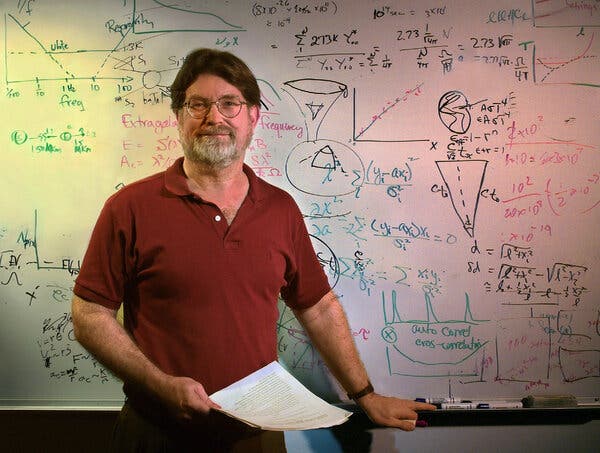Science
Renowned Physicist George F. Smoot Passes Away at 80

George F. Smoot, the influential American physicist and Nobel laureate, passed away at the age of 80 on September 18 at his home in Paris. His death was confirmed by his sister, Sharon Bowie, and was attributed to cardiac arrest. Smoot was widely recognized for his pivotal role in understanding the early universe, particularly for providing evidence of the primordial seeds that eventually formed galaxies and galaxy clusters.
Dr. Smoot was a research scientist at the Lawrence Berkeley National Laboratory and the Space Sciences Laboratory at the University of California, Berkeley. He led a team that developed an instrument in the 1970s, which was later launched into space aboard the NASA satellite, the Cosmic Background Explorer (COBE), in 1989. This instrument detected minute variations in the temperature of light that remained from the Big Bang, offering crucial insight into the universe’s formation.
Transforming Cosmology Through Groundbreaking Discoveries
The data collected by COBE provided a detailed map of how cosmic matter was unevenly distributed billions of years ago, establishing the foundational structure of the current universe. In 1992, when Dr. Smoot announced the COBE findings at an American Physical Society conference, he remarked, “If you’re religious, it’s like seeing God.” This declaration captured global attention, with The New York Times featuring it as the lead story on April 24, 1992, under the headline “Scientists Report Profound Insight on How Time Began.”
Renowned theoretical physicist Stephen Hawking described the findings as “the greatest discovery of the century, if not of all time.” Dr. Smoot’s research built upon the earlier work of physicists Arno A. Penzias and Robert W. Wilson, who in 1964 discovered the cosmic microwave background, confirming that the universe had a beginning.
Before Smoot’s contributions, cosmology lacked empirical data, relying heavily on speculation. The results from the COBE satellite fundamentally changed this, transitioning cosmology into a discipline supported by precise measurements.
A Complex Legacy and Continued Influence
In 2006, Dr. Smoot shared the Nobel Prize in Physics with John C. Mather, a cosmologist at NASA’s Goddard Space Flight Center, recognizing their collaborative achievements through the COBE project. While Dr. Smoot was celebrated for his brilliance, he faced criticism from some colleagues who felt he received disproportionate credit for the team’s scientific results. Just days before the pivotal conference in 1992, a news release from Berkeley Lab was perceived as attributing the discovery of the light temperature variations solely to Smoot, which sparked controversy among team members.
In his 1993 book, “Wrinkles in Time: Witness to the Birth of the Universe,” co-authored with Keay Davidson, Dr. Smoot chronicled the discovery process, although some collaborators disputed his portrayal of events. Dr. Mather later published his own account in “The Very First Light: The True Inside Story of the Scientific Journey Back to the Dawn of the Universe,” which differed in detail from Smoot’s narrative. In an interview, Dr. Mather acknowledged Smoot’s complexities, stating he was “ingenious and thoughtful and enthusiastic, as everybody knows.”
Born on February 20, 1945, in Yukon, Florida, Dr. Smoot was influenced by his parents, particularly his mother, a science teacher, and his father, a hydrologist. He pursued his education at the Massachusetts Institute of Technology, earning degrees in physics and mathematics in 1966, followed by a Ph.D. in particle physics in 1970.
Dr. Smoot’s career evolved as he transitioned from particle physics to cosmology, developing instruments to measure temperature differences in the cosmic microwave background. His innovative work led to significant discoveries, including the Milky Way’s velocity through space.
In addition to his scientific endeavors, Dr. Smoot dedicated time to public outreach, teaching high school teachers and students about cosmology. He also gained public recognition through appearances on popular television shows, including the CBS sitcom “The Big Bang Theory” and the game show “Are You Smarter Than a Fifth Grader?,” where he became the second person to win $1 million. Dr. Smoot noted that he donated his Nobel Prize winnings to establish scholarships and fellowships for aspiring scientists, emphasizing his commitment to education.
Dr. Smoot is survived by his partner, Nóra Csiszár, and his sister. His contributions to cosmology and public science education will leave a lasting legacy, inspiring future generations of scientists and enthusiasts alike.
-

 Science2 months ago
Science2 months agoInventor Achieves Breakthrough with 2 Billion FPS Laser Video
-

 Health2 months ago
Health2 months agoCommunity Unites for 7th Annual Into the Light Walk for Mental Health
-

 Top Stories2 months ago
Top Stories2 months agoCharlie Sheen’s New Romance: ‘Glowing’ with Younger Partner
-

 Entertainment2 months ago
Entertainment2 months agoDua Lipa Aces GCSE Spanish, Sparks Super Bowl Buzz with Fans
-

 Health2 months ago
Health2 months agoCurium Group, PeptiDream, and PDRadiopharma Launch Key Cancer Trial
-

 Top Stories2 months ago
Top Stories2 months agoFormer Mozilla CMO Launches AI-Driven Cannabis Cocktail Brand Fast
-

 Entertainment2 months ago
Entertainment2 months agoMother Fights to Reunite with Children After Kidnapping in New Drama
-

 World2 months ago
World2 months agoIsrael Reopens Rafah Crossing After Hostage Remains Returned
-

 Business2 months ago
Business2 months agoTyler Technologies Set to Reveal Q3 Earnings on October 22
-

 World2 months ago
World2 months agoR&B Icon D’Angelo Dies at 51, Leaving Lasting Legacy
-

 Health2 months ago
Health2 months agoNorth Carolina’s Biotech Boom: Billions in New Investments
-

 Entertainment2 months ago
Entertainment2 months agoRed Sox’s Bregman to Become Free Agent; Tigers Commit to Skubal









